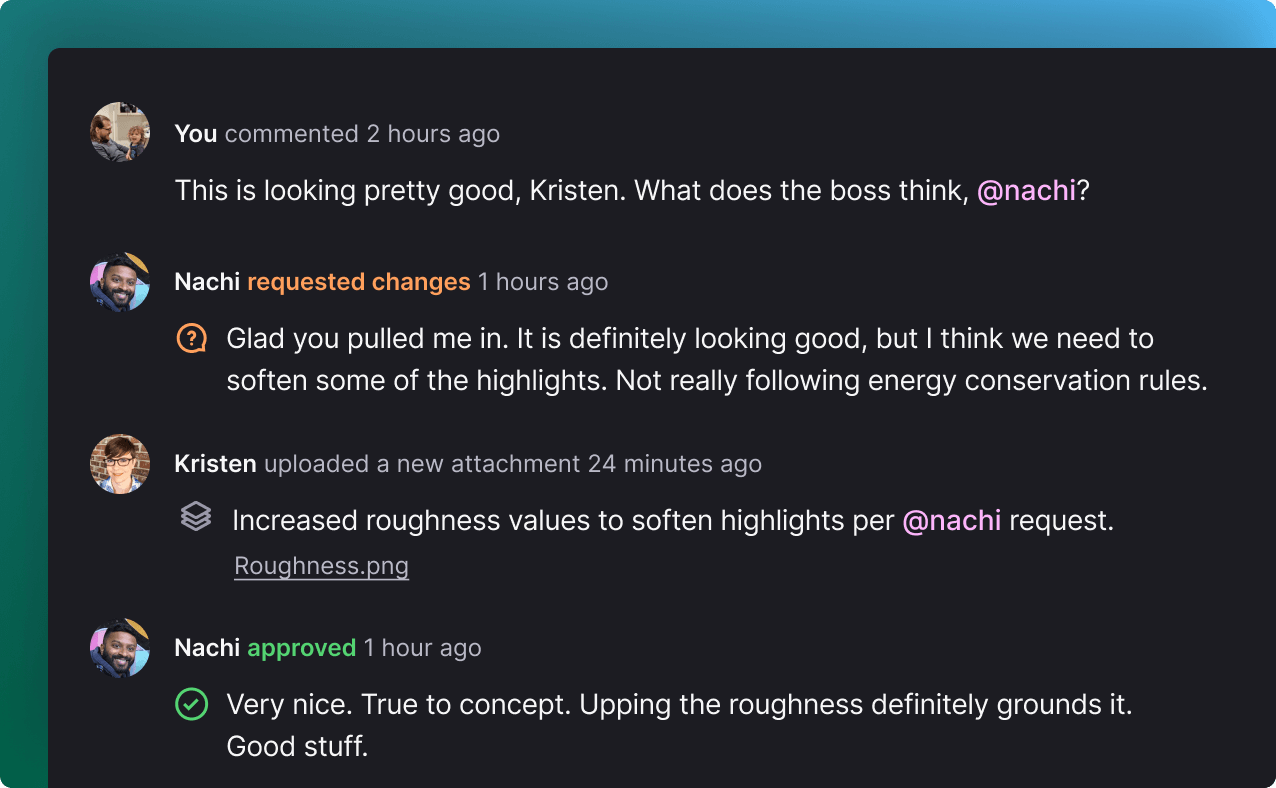
Sep 9, 2020
Seamless production handoffs are critical to maintaining a professional and fluid art pipeline. Every handoff has the potential to negatively impact artists downstream. It’s important to get these handoffs right the first time with high fidelity and confidence.
Avoid changes later by working together sooner.
No matter the final destination of any art asset, it is imperitive that the stakeholders have deep insight into the status of the artwork and communicate that status to relevant downstream parties. Other artists, designers, and developers need to know exactly what they are getting, when they might get it, and what the state of that content will be when the recieve it.
Stay consistent. Stay classy.
Every art pipeline needs consistency to be successful. Consistency limits chaos and creates easy patterns for everyone to follow. It allows us to identify issues sooner rather than later. The sooner you can identify a problem, the sooner you can solve it and move on. Moving fast and breaking things is the name of the game, but we want to make sure we move fast and break the RIGHT things.
If a technical artist / character rigger expects to get a mesh in quads every handoff, don’t you dare give them a bunch of triangles and ngons. Avoid the disruption downstream. Either you will have to circle around and clean that shit up, or that task will fall onto the poor technical artist. Either way, the break in consistency has disrupted your pipeline. Just say no. Maintain consistency.
Nobody likes to go digging for treasure on the job. Save that for the beach.
Always include any relevant supporting files or documentation.
Don’t make your colleagues dig around network drives, dropbox, or google drive for the files they need. Make sure they get everything they need in one bundle. Nobody likes to go digging for treasure on the job. Save that for the beach. Wrap up those beautiful files and add a bow on top for flair, but never forget a file your peer needs or expects.
Share files the same way, all the time, across all art groups.
Is it in my email? Did you send it to me in slack? Is it in our google drive? That link is expired. What is that complicated naming convention? Which version is the right one? I see 3 different versions that end in “_final”. Ok. I’ll try and get all of those files together tomorrow since I am busy with other tasks at the moment.
You’ve wasted so much time and energy already. Just pick one approach and make sure all the relevant parties follow the rules.
Everyone, in every discipline, should utilize version control.
It doesn’t matter whether you use complex naming conventions, subversion, git, or backup drives, but everyone should version control everything. Auto-rewrite (looking at you, you paranoid ctrl+s abusers) is the devil. Always write to a new file. Always upload versions to somewhere in the cloud. Flavor doesn’t matter, just make sure it’s consistent. The 42 versions on your machine don’t mean a damn thing if it catches on fire and the only version in google drive is out of date, or worse. Shit happens. Avoid the tilt. Version Control FTW.
For whatever reason, in our experience, the games industry has been notoriously slow to adopt robust version control practices from the top down. Small teams, indie studios, VFX and animation shops top the list. Most AAA studios have figured this out and either have a mandated approach, in-house solutioning, or some other flavor. I still hear horror stories all the time, where all I can do is shake my head and ask “did you try to roll back to your last version?”. Tears are the most common response.
Constantly request feedback from stakeholders and peers.

Frequent and continuous review provides meaningful direction and increases alignment between artists.
Everybody is super busy with loads to do. We get it. Don’t work with your head down for three days before syncing up with someone and seeking approval or validation. It doesn’t take much time but will save you SO much time. Trust us here. Change requests upstream ruin all downstream work. Get approval early and lock down that approval. Freeze changes and move forward. Don’t let uncertain leads or wishy washy executive stakeholders wrangle you repeatedly. Go to shop early and often. Document all approvals and change requests. Handoff with confidence.
This isn’t about covering your ass. It is about creating a consistent and streamlined art pipeline. Everything should flow forward. If the stream flows backwards, people are going to be battered. Gone are the days of over the shoulder approvals and feedback. You need to up your art review game and bring it into 2020+. Screensharing, screen captures, video recordings, presentations... whatever you have to do, just do it and get your feedback.
Use software to your advantage.
Project Management and Asset Management software is nothing new. Other industries have been utilizing solutions around this for decades. At mudstack, we believe it’s time for the games industry to revolutionize pipeline management and nail the art of the handoff once and for all.
This is why we built mudstack. We want to provide a seamless solution so you and your peers can own your art pipelines and collaborate with greater confidence and efficiency. All your files in one place, where you can manage your versions, reviews (approvals and change requests), supporting files, and workflows. Handoff your completed work with more confidence than ever while avoiding changes both up and downstream. Forget long winded art review meetings. Accomplish more, together, with constant feedback and collaboration.

